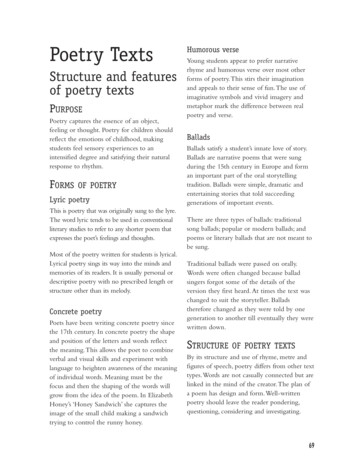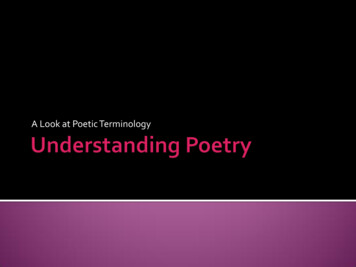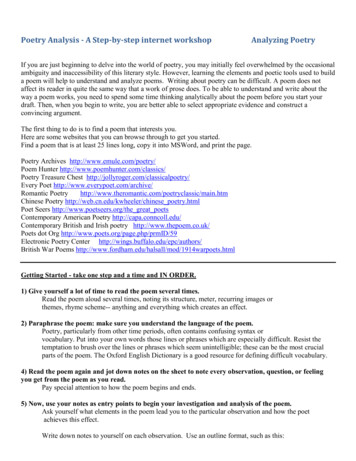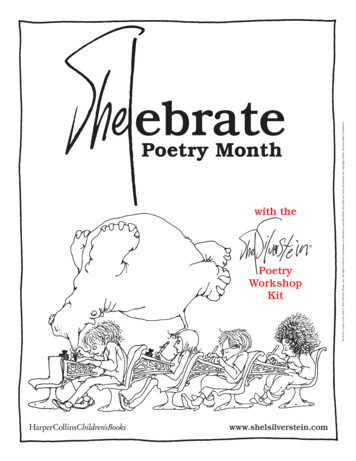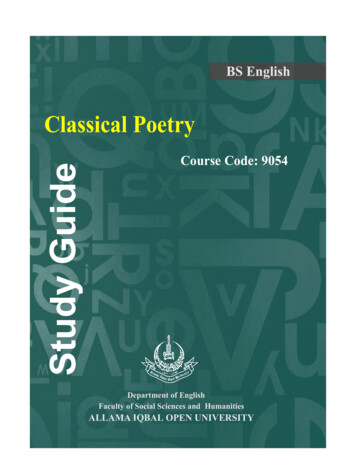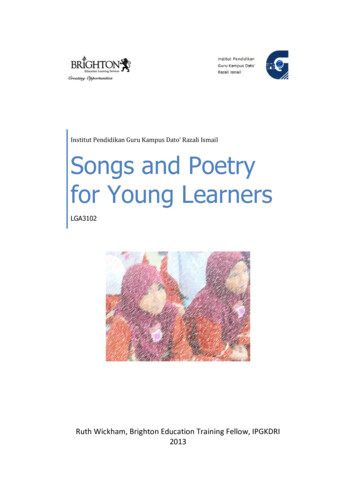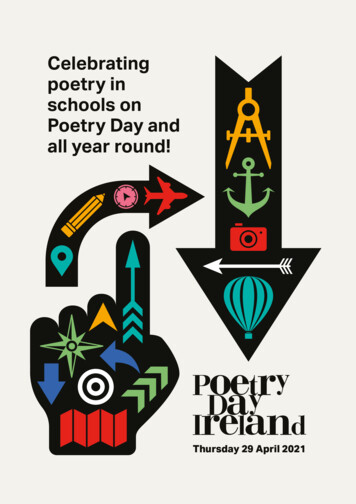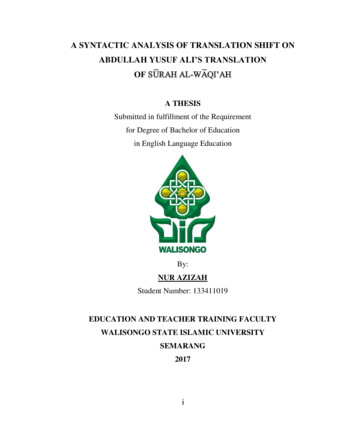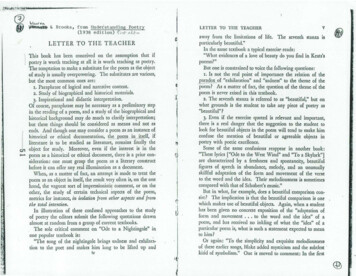
Transcription
View metadata, citation and similar papers at core.ac.ukbrought to you byCOREprovided by Repository Universitas Sanata DharmaIJHS, e-ISSN 2597-4718, p-ISSN 2597-470X, Vol. 3, No. 1, September 2019, pp. 76-83International Journal of Humanity nata Dharma University, Yogyakarta, IndonesiaPOETRY TRANSLATION ACCEPTABILITYON THE TRIALS OF APOLLO: THE HIDDEN ORACLE NOVELBintang Sukmajati and Patricia AngelinaSanata Dharma Universitybintangsukmajati@gmail.com and patricia@usd.ac.idDOI: https://doi.org/10.24071/ijhs.2019.030107received 26 July 2019; revised 29 July 2019; accepted 19 August 2019AbstractThis study aims to find out the extent of the acceptability of the poetry translationin the novel. One research question is formulated: To what extent is the poetrytranslations in The Trials of Apollo: The Hidden Oracle acceptable based onLarson’s criteria of an acceptable translation. Qualitative research by using the textanalysis was conducted. The data of this research were taken from both theEnglish and Indonesian version of The Trials of Apollo: The Hidden Oracle novel.In order to answer the research question, the researchers compared the translationbetween the English and Indonesian poetry using the theory of acceptability byLarson. The results show that there are 36 poetry translations which arecategorized as acceptable and three poetry translation which are unacceptable. The36 poetry translations incorporate at least two out of the three poetry translationsacceptability criteria, while the three poetry only fulfil one poetry translationacceptability criterion.Keywords: poetry translation, acceptability, The Trials of Apollo: The HiddenOracleIntroductionTranslation does not merely mean changing the source language into thetarget language, especially in literary works (Newmark, 1988). Some aspects needto be considered in order to have an acceptable translation. An acceptabletranslation will make the readers not only understand the meaning, but also obtainthe appropriate meaning of the literary works. The form of an acceptable literarywork translation, especially poetry, has not been exposed clearly because someexperts even believed that poetry cannot be translated. Therefore, poetrytranslation needs to be analyzed.Poetry is the freest type of literature works whose words have powerfulmeaning (Newmark, 1988). Since the words have powerful meaning, poetry ismore difficult to understand compared to other literary works. In order to makepoetry easier to be understood, poetry should be translated. However, translatorscannot simply translate poetry. It is due to the ‘powerful words’, which are oftenbeing represented in the form of morpheme or idiom. In translating, the source76
IJHS, e-ISSN 2597-4718, p-ISSN 2597-470X, Vol. 3, No. 1, September 2019, pp. 76-83language meaning and style should be able to be delivered into the target languageas natural as possible (Nida, 1974, p. 12). It means that the translators should beable to find the same ‘powerful words’ with the context of the target language.Novel translation is the second most difficult literary works to be translatedafter poetry because it has lots of metaphors and idioms (Newmark, 1988).Metaphors and idioms cannot be translated word-for-word. Translators shouldknow the equivalent metaphors and idioms in order to make the translationacceptable. Hence, when translating poetry in a novel, someone should considermore aspects rather than translating a poem or a novel alone. Thus, this study isexpected to be able to explore more about translating poetry in a novel.The Trials of Apollo: The Hidden Oracle novel was chosen because thepoetry translation in that book is different from the translation of poetry in ananthology book. The poetry in that novel has restricted context. The poetry iswritten in every chapter, under the chapter number. It is a summary of the story inthe books. In an anthology book, the poetry translation acceptability can beanalyzed directly, but in this novel we should read the chapter first before we candetermine whether the translation of the poetry is acceptable or not. Therefore, thepoetry translation in this novel needs to be analyzed.The Trials of Apollo: The Hidden OracleThe Trials of Apollo: The Hidden Oracle is the first part of pentalogy novel,The Trials of Apollo, by Rick Riordan. This novel was first published in 2016 inthe United States by Disney Hyperion and in Great Britain by Puffin Books. TheIndonesian version was first published in 2017 by Penerbit Naura Books. Thisnovel contains 39 chapters. In the beginning of every chapter, there is a poemwhich summarizes the events that happen in that chapter.Translation AcceptabilityTranslation acceptability is the measurement of whether a translation can becategorized as a good translation or not. According to Larson (1984), a translationshould firstly, use the natural form of the target language, which means thetranslation is not stiff. In other words, it uses the daily language of the targetlanguage. Secondly, it should deliver the same meaning from the source languageinto the target language, which means it does not change the meaning or lose its’essential meaning (p. 6). Lastly, it should maintain the dynamic of the originalsource language text, which means that the translation can give the same feelingto the receptor in the target language with the receptor in the source language(Larson, 1984, p. 6). Related to the theory of translation acceptability, a poemshould focus more on the meaning of the word rather than focusing to find thesame word. It means some words may be very different after being translated intothe target language. In other words, to get an acceptable translation, translatorsshould prioritize some things over the others. According to Nida (1974),“Contextual consistency has priority over verbal consistency, dynamicequivalence has priority over formal correspondence, the aural form of languagehas priority over the written form, and forms that are used by and acceptable tothe audience for which a translation is intended have priority over forms that maybe traditionally more prestigious” (p. 14).77
IJHS, e-ISSN 2597-4718, p-ISSN 2597-470X, Vol. 3, No. 1, September 2019, pp. 76-83MethodThis study used the text analysis method. A text analysis method is a type ofcontent analysis in which the researcher analyzes and interprets documents to givevoice and meaning around an assessment topic (Neuendorf, 2002). The type ofthis research data was literary works. The data were 39 poems from the Englishversion of The Trials of Apollo: The Hidden Oracle novel and 39 poems from theIndonesian version. Purposive sampling was used because only the poetry in thebeginning of the chapter were analysed. The poetry inside the chapter were notanalyzed because they have different forms from the poetry in the beginning ofthe chapter. The poetry in the beginning of the chapter is haiku, while the poetryinside the chapter are free poems, limerick, and pantun.The instrument used was a checklist on poetry translation acceptability. Itconsisted of two parts, namely the theory of poetry translation acceptability byLarson and the poetry in the beginning of each chapter inside the book. The datawere analysed in three steps as proposed by Ary, Jacobs, and Sorensen (2010)namely organizing and familiarizing, coding and reducing, and interpreting andrepresenting (p. 481). In the first step, the literal and connotative meaning of eachword or phrase used in the poetry were identified and organized by listing themfrom chapter one until chapter 39. The second step was coding every line of thepoetry depending on the existence of metaphors. The last step was interpretingand representing, which was conducted by comparing the English with theIndonesian version to find out whether the translation was acceptable or not basedon Larson’s theory of an acceptable translation in the checklist. The poem isconsidered as acceptable if there are at least two criteria of acceptabilitytranslation by Larson present. After that, the results were presented using a piechart.Findings and DiscussionAcceptable Poetry Translation in The Trials of Apollo: The Hidden OracleReferring to Larson’s translation acceptability theory (1984), a translationshould use the natural form of the target language, deliver the same meaning tothe target language, and maintain the dynamic of the source language (p. 6). Thereare 36 poetry translations which are categorized acceptable. The first example ofacceptable poetry translation is found in Chapter 1, which is presented in Table 1below.Table 1. Acceptable Poetry Translation in Chapter 1Meaning in IndonesianLineCodeMukaku kena hajarHoodlums punch my faceE1.L1I would smite them if I couldE1.L2Mortality blowsE1.L3Si preman pantas binasaNahasnya aku fanaCodeI1.L1I1.L2I1.L3If the first line is translated literally, it will be Preman menghajar mukaku.Meanwhile, the second line will be Aku akan menghantam mereka jika aku bisa,and the third line will be Kefanaan meniup. However, as shown in Table 1, thetranslation of E1.L1, E1.L2, and E1.L3 are not literal. In I1.L1, the word“Hoodlums” is not translated. It is put on the second line. It is similar to thetranslation of E1.L2. The subject “I” is not translated on the second line.78
IJHS, e-ISSN 2597-4718, p-ISSN 2597-470X, Vol. 3, No. 1, September 2019, pp. 76-83However, if it is read as one unity, it delivers the same meaning that is Apollowants to take revenge for the hoodlums. It is not translated literally because thetranslator wants to maintain the dynamic of the source language. Thus, thetranslator uses the word preman in the second line and the word “I” which shouldbecome a subject is changed into clitics –ku, which has a role as possessivepronoun, in the first line. E1.L3 is also not literally translated because in thesecond word there is a metaphor, that is “blows”. The word “blows” in thatcontext means mengacaukannya not meniup. After finding the appropriatemeaning of the metaphor, the translator paraphrases the phrase to make thetranslation become more natural in the target language. It is not translated askefanaan mengacaukannya but nahasnya aku fana.Table 2. Acceptable Poetry Translation in Chapter 2Meaning in IndonesianLineCodeA girl from nowhereE2.L1Anak perempuan entah dari manaCompletes my embarrassment E2.L2Menggenapkan aibkuDasar pisang celakaStupid bananasE2.L3CodeI2.L1I2.L2I2.L3The second example of acceptable poetry translation is found in Chapter 2. Inthis poetry, the first line is translated literally, which becomes Anak perempuanentah dari mana. The second line has the same case. However, the third line isquite different. When E2.L3 is translated literally, it becomes Pisang bodoh.Though it is not translated literally, “stupid bananas” is not a metaphor. It is weakswear words. Hence, in order to make the translation of the swear words becomesnatural in Indonesian, it becomes Pisang celaka.The third example of the acceptable poetry translation is also not translatedliterally. The first line is a Spanish phrase which means Rumah Jackson.However, it is translated into Di Istana Jackson. The Spanish phrase is actually aslang which is derived from borrowed words. Apollo uses Spanish language as aslang because he wants to make a glorious image of Percy Jackson’s house whichis actually a sarcasm. Therefore, it is translated into istana. The second line istranslated literally, but it is simplified. The word tiada replaces the words tidakada and the word emas is deleted. Hence, instead of writing tidak ada takhtaberlapis emas untuk tamu, it is translated into Tiada takhta emas untuk tamu. Thelast line is also not translated literally because it is slang. The word “dude” meansbung in Indonesian. The word “dude” also has the equivalent one in Indonesianthat is bro. Thus, when it is translated literally, it becomes Yang benar saja, bung?or if the slang wants to be kept, it can be translated as Yang benar saja, bro?However, both options do not maintain the dynamic of the source language aswell as Terlalu! Therefore, to fulfil the three criteria of acceptable poetrytranslation, E4.L3 is translated into Terlalu! The complete list is presented inTable 3 below.79
IJHS, e-ISSN 2597-4718, p-ISSN 2597-470X, Vol. 3, No. 1, September 2019, pp. 76-83Table 3. Acceptable Poetry Translation in Chapter 4Meaning in IndonesianLineCodeDi Istana JacksonCasa de JacksonE4.L1No gold-plated throne for guestsE4.L2Seriously, dude?E4.L3Tiada takhta emas untuk tamuTerlalu!CodeI4.L1I4.L2I4.L3The last example has a slang which is modified into someone’s nickname.The nickname is “Hunk Muffin”. Literally, hunk means bongkahan. In slangdictionary hunk (hunk of a man) means a well-built, sexually attractive man.Muffin refers to a kind of small cake. In Indonesian, muffin is still named muffin,but it will be added kue as modifier, so it becomes kue muffin. Some also removesone of the “f”, so it becomes kue mufin. Hence, when it is translated literally, thethird line becomes bongkahan kue muffin, or when it is translated using the slangdefinition it becomes laki-laki seksi yang seperti kue muffin. It can be seen that“Hunk Muffin” does not has an equivalent word in Indonesia. Therefore, thetranslator should make a new nickname which can represent “Hunk Muffin”. Inorder to do that, the translator should think of the person who obtain this title,Leo. Leo is a small but attractive boy. The word kakanda is used to call a brotherin a kingdom or a lover sweetly. It means that the one who is called kakanda ischarming like a prince or a boyfriend. Meanwhile, the word imut is the same with“cute” in “Peter is cute, isn’t he?” Hence, Kakanda Imut could represent Leo andgive the same vibes with “Hunk Muffin”, which is a small but attractive boy. Thenext phrase “earned” is quite literal. It only specifies the “it”. It in E39.L3 refersto the word “hit” in E39.L1. The second line and the first line are also literal.However, in I39.L1, there is a word katamu. The addition of this word does notchange the meaning at all. It is only used to make the translation more natural.Table 4 describes the content clearly.LineTable 4. Acceptable Poetry Translation in Chapter 39Meaning in IndonesianCodeWant to hit Leo?E39.L1Ingin memukul Leo, katamu?CodeI39.L1That is understandableHunk Muffin earned itE39.L2E39.L3Bisa dimaklumiKakanda Imut patut ditinjuI39.L2I39.L3Unacceptable Poetry Translation in The Trials of Apollo: The Hidden OracleThere are three poetry translations which are categorized as unacceptable.These poetry translations are unacceptable because the meaning and dynamic ofthe source language, which are included as the second and third criteria ofacceptable poetry translation, are changed. The first example of unacceptablepoetry translation is found in Chapter 3. When the first line is translated literally,it is good. It uses the natural language of the target language, delivers the samemeaning from the source language, and maintains the dynamic of the sourcelanguage. However, the second line does not maintain the dynamic of the sourcelanguage because the diction in I3.L2 is just the core of the E3.L2. It does notdeliver the sadness Apollo feels. When E3.L2 is literally translated, it becomesSekarang di tengah kota merasa sedih. It is definitely not natural, so the translatordecides to take the substance of the line which is Apollo is very sad. Merana is80
IJHS, e-ISSN 2597-4718, p-ISSN 2597-470X, Vol. 3, No. 1, September 2019, pp. 76-83equivalent to “very sad”. It means that it delivers the meaning of the content fromthe source language. The translator could simply say merana instead of sekarangdi tengah kota merasa sedih. However, if he or she just uses the word merana, itmakes the source language loses its feeling. Therefore, the translator should havemade a new sentence which is poetic enough to deliver the sorrow Apollo feels.The third line also does not deliver the same meaning and does not maintain thedynamic of the source language. Of course “Bah, haiku don’t rhyme” could not betranslated literally because it will become unnatural in the target language.Therefore, the translator decides to take the core of line and change the diction.However, the translator may get the meaning wrong. Poetry which is not rhymedis bad. In Indonesian, “bad” is payah. Hence, it is translated into Ah, payah.However, haiku is not necessarily rhymed. In fact, most haiku are not rhymed. Ah,payah is more natural and be easier to understand than Ah, tak berima, whichfulfils the first and second criterion of acceptable translation. However, themeaning is distorted. Though Nida (1974) states that a good translation should beeasily understood, but it is useless if the meaning misleads the reader (p. 173).Moreover, this poetry translation only uses the correct punctuation principle.Hence, this translation is unacceptable because it only preserves the natural formof the target language and ignores the other aspects and principles. The details arepresented in Table 5 below.LineTable 5. Unacceptable Poetry Translation in Chapter 3Meaning in IndonesianCodeUsed to be goddyE3.L1Dahulu dewaNow uptown feeling shoddyBah, haiku don’t rhymeE3.L2E3.L3Sekarang meranaAh, payahCodeI3.L1I3.L2I3.L3In the second example of unacceptable poetry translation, E7.L1 and E7.L2have been translated into I7.L1, I7.L2, and I7.L3. It is translated literally andnaturally into the target language because it does not contain any metaphor. Theproblem is the last line is missing or not translated. It is different from the seventhexample. The seventh example also has a line which does not exist in the otherlanguage, but the missing one is the line in target language. However, in thistranslation the missing one is the line in the source language or deletion. Additionis better than deletion if the addition does not change the core of the sourcelanguage such as in the poetry chapter 22. On the other hand, deletion is notacceptable because it eliminates the meaning and may influence the dynamic ofthe source language. In this example, “Have fun with that, LOL” is a sarcasm forthe Apollo’s condition. In that condition, Apollo is desperate but he does not lookmiserable. Instead, he is still able to make fun of them. It changes the meaningand the dynamic of the source language when the line is deleted because it makesApollo seem miserable. In addition, this poetry translation only uses the firstprinciple; correct punctuation. Hence, this poetry translation is unacceptablebecause it only fulfils one criterion and uses only the correct punctuationprinciple. The analysis of the poetry is presented in the following table.81
IJHS, e-ISSN 2597-4718, p-ISSN 2597-470X, Vol. 3, No. 1, September 2019, pp. 76-83Table 6. Unacceptable Poetry Translation in Chapter 7LineCode Meaning in IndonesianTag with plague spiritsE7.L1Kejar-kejaran dengan roh wabahpenyakitYou’re it, and you’re infectious E7.L2Jangan sampai tertangkapKalau tidak mau sakitHave fun with that, LOLE7.L3CodeI39.L1I39.L2I39.L3In the third and last example of unacceptable poetry translation, only E14.L1which is translated properly in I14.L2. E14.L2 and E14.L3 are nowhere to befound. As a consequence, I14.L1 and 14.L3 also do not exist in the sourcelanguage when it is back-translated. When E14.L2 is translated literally, itbecomes Hei, sialan, apa yang baru saja terjadi? or, if it is changed into a morenatural form, it becomes Apa? Sial. Apa yang terjadi sih? However, as mentionedbefore, there is no sentence similar to that in the Indonesian version. The last linehas a similar case. When E14.L3 is translated literally, it becomes Aku kehabisanka-. There is no similar sentence existing in the Indonesian version. This is thething that should not be done by the translator. The translator should havetranslated it literally if there is no metaphor. Moreover, these lines can easily looknatural when it is translated literally. As mentioned above, the translator takes thecore and remakes the lines. It is in line with what Newmark (1988) suggestedabout translating a poem by taking the core and then making a new poem (p. 70).However, it does not need to be done if it changes the meaning rather thantranslating it word-for-word. It is different from the poetry in Chapter 17. Inchapter 17, the translator also only takes the core but it is necessary to be donebecause it contains metaphors which do not have equivalence in Indonesian.Moreover, this poetry translation does not use any principle. Hence, this poetrytranslation is also unacceptable because it completely changes the meaning andthe dynamic of the source language and does not use any poetry translationprinciple. The details are presented in the following table.Table 7. Unacceptable Poetry Translation in Chapter 14Meaning in IndonesianLineCodeKamu anak siapa?You’ve got to be kidE14.L1Well, crud, what just happened there?E14.L2I ran out of syl-E14.L3Apa, bercanda, ya?!Wah, gawat iniCodeI14.L1I14.L2I14.L3ConclusionThere are four points that can be concluded from the study. First, to decidethe acceptability of the poetry, the interpretation method should be used to findthe core of the poetry. Second, the poetry translation is influenced by the contentof the chapter or the context. Third, syllable does not influence the acceptabilitybecause Indonesian tends to have more syllables than English. In other words,preserving the meaning is more important than following the syllable rule. Fourth,to get an acceptable poetry translation, translators do not always need to followthe poetry translation principles but still need to consider the poetry translationprinciples.82
IJHS, e-ISSN 2597-4718, p-ISSN 2597-470X, Vol. 3, No. 1, September 2019, pp. 76-83ReferencesAditia, H. (2011). An analysis of taboo word and swear word in Dustin LeeAbraham’s how high movie (Undergraduate thesis). State Islamic University“Syarif Hidayatullah”, Jakarta. Indonesia.Ary, D., Jacobs, L. C., & Sorensen, C. (2010). Introduction to research ineducation (8th ed.). Belmont, CA: Wadsworth.Bassnett, S. (2002). Translation studies (3rd ed.). New York: Routledge.Carey, G. V. (1957). Punctuation. London: Cambridge University Press.Eble, C. (1996). Slang & sociability: In-group language among college students.Chapel Hill: The University of North Carolina Press.Goatly, A. (1997). The language of metaphors. London: Routledge.Green, J. (1993). Slang down the ages. London: Kyle Cathie Limited.Herlambang, M. A. K. (2017). A study of translation equivalence andacceptability on the subtitle of Intel advertisement (Undergraduate thesis).Sanata Dharma University, Yogyakarta, Indonesia.Lakoff, G., & Johnson, M. (1980). Metaphors we live by. London: The Universityof Chicago Press.Larson, M. L. (1984). Meaning-based translation: A guide to cross-languageequivalence. London: University Press of America, Inc.Nababan, M. R. (1999). Teori menerjemah Bahasa Inggris. Yogyakarta: PustakaPelajar Offset.Neuendorf, K. A. (2002). The content analysis guidebook. Thousand Oaks, CA:Sage Publications.Newmark, P. (1988). A textbook of translation. Hertfordshire: Pretince Hall.Nida, E. A., & Taber, C. R. (1974). The theory and practice of translation.Leiden: E. J. Brill.Riordan, R. (2016). The trials of Apollo: The hidden oracle. London: PenguinRandom House UK.Riordan, R. (2017). The trials of Apollo: The hidden oracle. (R. Indardini, Trans.).Jakarta: Penerbit Noura Books. (2016).Stroilova, A. G., & Makarova, A. A. (2016). Russian translations of ThomasGrey’s elegy written in a country church-yard in 18th-19th centuries. Socialand Behavioral Sciences 231, 187 – 194. Retrieved from 77042816312010main.pdf? tid ead63683-0efb-49a0-8b485c5c323df417&acdnat 1521711105 cfa4dd578f0ddfd876cb0a811e7b37e aTisgam, K. H. (2014). Translating poetry: Possibility or impossibility? J. ofCollege of Education For Women, 511-524. Retrieved fromhttps://www.iasj.net/iasj?func fulltext&aId 91622Veckrācis, J. (2016). Translations of Joseph Brodsky’s poem “May 24, 1980” intoEnglish and Latvian: Cross-linguistic, cross-cultural and interpretativecomponents of text analysis. Social and Behavioral Sciences, 231, 179-186.Retrieved from 77042816312009-main.pdf? tid 2741e0e8-9ab9-4110-beac992fa46e8c77&acdnat 1521711298 95b1e92ebf4b3ca5986ff5ac169ff64bWojowasito, S., & Poerwadarminta, W. (2007). Kamus lengkap Inggris Indonesia Indonesia - Inggris dengan ejaan yang disempurnakan. Bandung:Hasta.83
The Trials of Apollo: The Hidden Oracle The Trials of Apollo: The Hidden Oracle is the first part of pentalogy novel, The Trials of Apollo, by Rick Riordan. This novel was first published in 2016 in the United States by Disney Hyperion and in Great Britain by Puffin Books. The Indonesian version was first published in 2017 by Penerbit Naura Books.


